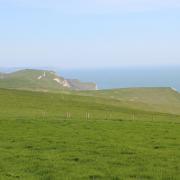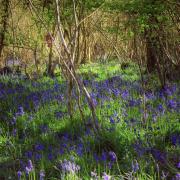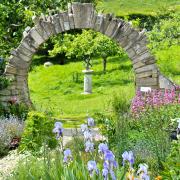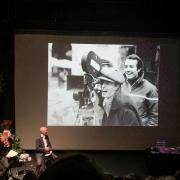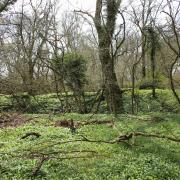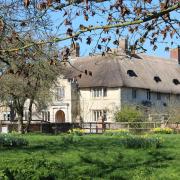From the rapture of a lonely shore to the pleasures of a pathless wood, artist Teresa Lawton’s abstract paintings are her instinctive response to Dorset’s natural beauty
Every morning and evening Teresa Lawton takes her dog, Luca, for a walk. In winter they follow the coast path towards Purbeck, in summer they visit Puddletown Forest. They might explore the habourside at Weymouth, or the watery inlets and crumbling jetties around the outer reaches of Poole Harbour. In between the walks, Teresa paints.
“The walks are a vital source material for me,” she says. “I can spend that precious time being quiet, looking and thinking. A simple horizon line at sea, the tangled nets and ropes of fishing boats, or the light falling in dark woodland – these are my inspiration.”
Teresa started painting relatively late in life, taking a foundation course at Bournemouth College of Art and Design in her thirties. During the course, she visited St Ives and was inspired by the wealth of artists that worked in West Cornwall in the 1920s through to the 1960s, especially Ben Nicolson, Roger Hilton, Peter Lanyon and the self-taught ‘primivitist’ Alfred Wallis.
“I’ve always been such an outdoorsy person and going to St Ives and seeing their work in its natural setting meant I really got it, it was a revelation and became an absolute passion.”
Her interest in the St Ives painters, she tells me, fuelled her commitment to abstraction. “When I started my work was very ‘St Ives’ and blue with lots of boats. Galleries liked that, but I was curious to go on and explore further and work with a new set of ideas. I’m always challenging myself to make something new.
“That said, my paintings still have a lot of structure in them and the structure is an important scaffold; it creates an order in which I am able to work.”
This structure is highly evident in works such as ‘Walkways’ and ‘Night-time Promenade’, which take harbour elements such as ropes, boats and jetties and re-order them into a new pattern. It’s also there in a simpler and more mysterious form in ‘The Lookout’ and ‘Running Deep’.
“When you are an abstract painter you play with what’s around you. You’re creating colours, mixing paints, making all the edges work together in some kind of relation; it doesn’t have to be a harmonious relation, they can be in discord, but they have to react to each other - that’s what it’s all about.”
Over the years Teresa’s paintings have earned a deservedly fine reputation and she sells her work in several prestigious galleries in London and the UK. In Dorset, she’s represented by The Art Stable in Child Okeford, which is holding a solo exhibition of her work this autumn. The exhibition is call ‘Still Waters’ and features Teresa’s latest paintings - a mix of coastal-inspired pieces and inland works prompted by walking through woods and observing the contrast of light and dark, sunlight and shade. All of them are painted in her usual medium of oil on canvas at home in her small studio in Upwey.
“I love working in oils because they’re so tactile and slow drying. I add layers and layers of thin paint on top of each other to build up the surface. The more you work it the more interesting it becomes and you’ve got a good week before it dries. Acrylics are too quick for me but oils allow me time.”
At the moment Teresa is painting on much larger canvases. “I love having a simple structure and lots of space to work up the surface,” she confesses.
“I think it’s the work you put into a painting that makes people want to buy it. You can’t work just to sell; you have to be honest as a painter. Painting has a mystery to it and your work will resonate with some people and not others, in the same way that some music will hit the right note and some won’t. I paint because it’s really important to me to communicate that mystery to those people who can hear it.”
***
Four art-inspiring walks
Teresa uses her time out walking to study the landscape and formulate ideas for her work. Here are four of her top recommendations for inspiring creativity:
• Puddletown Forest: conifers give dramatic contrasts between light and shade. Lots of well-marked footpaths and easy access from the A35. Good chance of seeing deer.
• Studland Beach: A wonderful winter walk with beautiful sand dunes. The bird watching hides provide interesting structures in the natural landscape.
• Weymouth Harbour and Nothe Fort: Lots of colour, lines and edges urging you to make order from the chaos.
• South Dorset Ridgeway: Superb views all the way from Weymouth to Abbotsbury. The Ridgeway takes you through many of Dorset’s most significant archaeological sites where traces of habitation date back thousands of years. The landscape has been reworked many times rather as a painter might rework the surface of an oil painting.
--------------------------------------------------
Read on
• TV series partly filmed in Wimborne and Weymouth features 2 Dorset artists• Bridport’s unique characters photographed by Kevin Wilson




